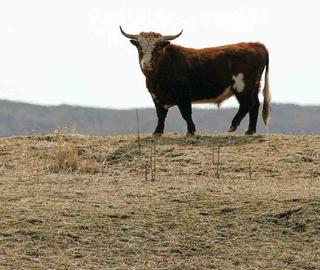Sand Point Residents Weigh In on Wild Cattle Removal

Wednesday, January 29 2014
On January 15, the U.S. Fish and Wildlife Service held an open house in Sand Point as part of a public process to address unauthorized wild cattle herds. The animals are on two islands owned by the Alaska Maritime National Wildlife Refuge.
Refuge manager Steve Delehanty said the biologists were visiting Sand Point "just to learn, really."
"To learn what the perspectives are of the people who live right here in Sand Point and are closer to the issue and know a lot about it," Delehanty said. "We haven't made any decision about what we're doing [with] these two islands. They're called Chirikof and Wosnesenski."
Wosnesenski Island is about 35 air miles from Sand Point and has a long history with local residents. David Osterback, owner of the Wosnesenski herd and president of the Qagan Tayagungin tribe, said his family settled on the island in the late 1800s.
Osterback said his grandfather brought the cattle there in the 1930s -- and did it lawfully.
"My grandfather, my dad and myself paid a grazing lease for years and years and years until we were told that we didn't have to anymore, and that they would notify us again whenever they decided who was going to own the land, and who we had to pay to lease to," Osterback said.
FWS biologist Steve Ebbert said he's heard public concerns he about the impact of wild cattle on the islands’ environment, salmon streams and even archaeological sites.
"We've heard from archaeologists who've said, 'You are not protecting the archaeological resources -- a finite resource on the island. Their vegetation is gone, the sites are blowing away, they're disappearing in the sea, and you're not fulfilling your responsibilities,'" Ebbert said.
This is not the first time the Fish & Wildlife Service has dealt with wild cattle in the eastern Aleutians. In 1985, the Fish and Wildlife Service removed all cattle from Simeonof, Chernabura and Caton islands.
About 150 cattle were shot and killed on Simeonof Island between 1985 and 1986. But Ebbert said that ten animals were simply relocated.
"One Fish and Wildlife Service [member] and one helicopter went to help move those cattle to Unga [Island] for the Shumagin Corporation," Ebbert said.
Residents at the open house said they wanted to see the herds continue to be locally managed. The ten cattle moved from Simeonof to Unga Island are now about 100 head. They're managed by the Unga Corporation. The bison herd of about 120 head on Popof Island are managed by the Shumagin Corporation.
Tiffany Jackson is the executive director of the Qagan Tayagungin tribe. She said the cattle are important for subsistence users, and shouldn't be destroyed.
"Local people have demonstrated the ability to successfully manage grazing animals on these islands and have the bird populations flourish," Jackson said. "It meets a number of your priorities. I don't know where subsistence lies in that list; wildlife seems to be above that. But we've been able to [meet] that here."
This scoping process is the start of a journey to develop environmental assessments or impact statements. Those will guide the refuge in resolving the cattle issue. The Fish and Wildlife Service held open houses in Homer and Kodiak as well.
They're taking public comments on the cattle issue through Friday, January 31.




Tina on Friday, January 31 2014:
I believe some info is incorrect. USFWS didn't assist in moving the cattle off of Simeonoff Island, USFWS and one helicopter went out there and slaughtered approximately 500 head of cattle. The 10 surviving cows were moved by local Sand Point fishermen on a fishing vessel. There are approximately 30 cattle on Unga, not 100.